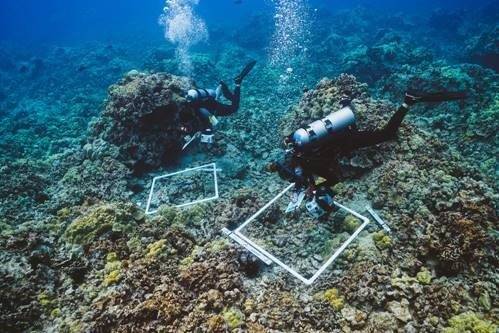
Team of UH-Hilo students, faculty publish work on coral health and disease

Courtesy photo Students from the University of Hawaii at Hilo EPSCoR `Ike Wai Summer Research Experience survey coral health and collect imagery for 3-D reconstruction on coral reefs off the Kona Coast.
Students and faculty in the ‘Ike Wai Research Experience in Data Science Program at the University of Hawaii at Hilo had their work on coral health and disease published in the May 6 edition of Frontiers Marine Science.
The publication is the result of research done during the summer of 2019.
“A Comparison of the Diagnostic Accuracy of in-situ and Digital Image-Based Assessments of Coral Health and Disease” addresses a pressing issue in the field of marine science, which is the capability of digital images to be used for detecting disease in marine environments.
The students conducted underwater conventional coral health surveys and subsequently collected imagery for high-resolution 3-D models of the same study plots. This unique approach allowed them to compare coral health assessments from visual surveys and digital analysis. The findings showed that the human visual assessment is more sensitive for detecting disease than the digital approach. The digital approach was comparable, however, and thus can be a useful tool when human divers cannot safely access reef habitats for visual surveys.
As agencies around the globe are adopting digital imaging methods for monitoring reefs, this paper provided useful clarity of the pros and cons of using new technologies versus conventional techniques.
The students involved in the publication include Sofia Ferreira, Drew Gotshalk, Chad Kinoshita, Micah Marshall, Nicholas Del Moral, Shane Murphy, Kailey Pascoe, Alexandra Runyan, Alexander Spengler, Brittany Wells and Danielle Wilde. Faculty members were John Burns, Grady Weyenberg and Travis Mandel.
“This project was a close collaboration between students and faculty in marine science, computer science and mathematics,” said Weyenberg, assistant professor of mathematics and co-author of the publication. “Everybody got to learn a bit about how marine scientists conduct coral surveys, the CS problems involved in building 3-D models from photographs and the math modeling and computation that goes into more advanced Bayesian statistical models.
“The research is quite novel for marine science, as there have been very few studies comparing the accuracy of the two methods of diagnosing coral reef health. From a statistical point of view, the problem is interesting because when the two methods disagree, we have no ‘gold-standard’ available to tell us which method is correct and which is wrong, so we must build that uncertainty into our models when comparing the methods,” he explained.
“This was a really great example of advancing science in an interdisciplinary manner,” added Burns, assistant professor of marine science and co-author of the publication. “The students did an amazing job on all aspects of the project. They all brought varying levels of expertise that enabled us to quickly collect a large dataset from Hawaiian reefs and analyze it using various technological tools.
“By the end of six weeks, they had completed all analyses and prepared the first draft of the manuscript as well as put together some exceptional presentations. To me, this project and resulting paper really capture one of the main goals of the UH-Hilo data science program, which is bringing together students from multiple disciplines to conduct exciting applied research.”
The ‘Ike Wai Research Experience in Data Science Program is funded through UH-Hilo’s participation in the $20 million ‘Ike Wai project awarded to the state in 2016 by the National Science Foundation’s Experimental Program to Stimulate Competitive Research (EPSCoR).
The full paper is available online at www.frontiersin.org/articles/10.3389/fmars.2020.00304/full.
